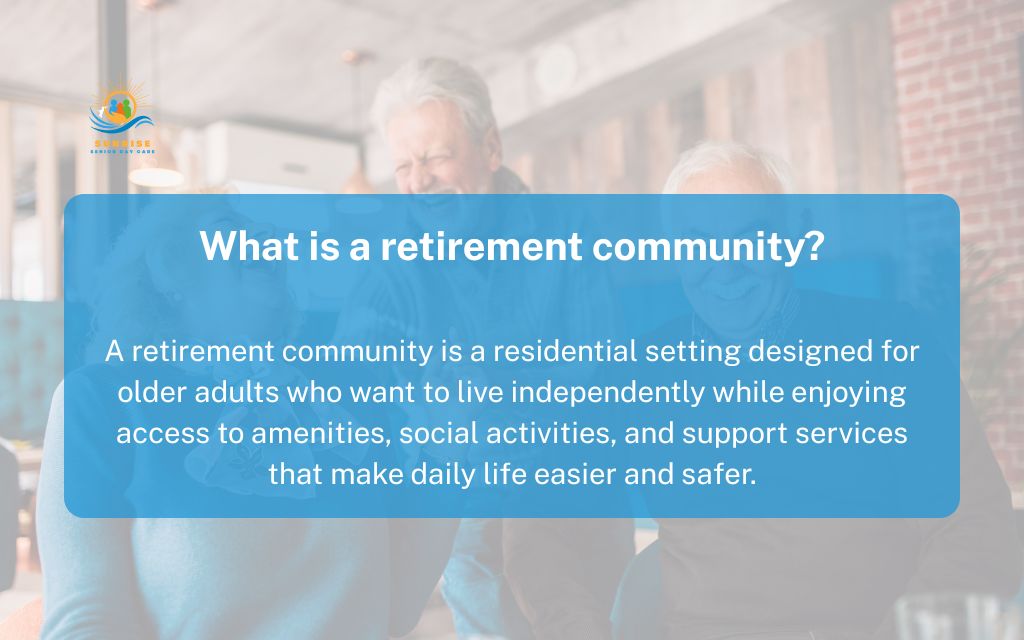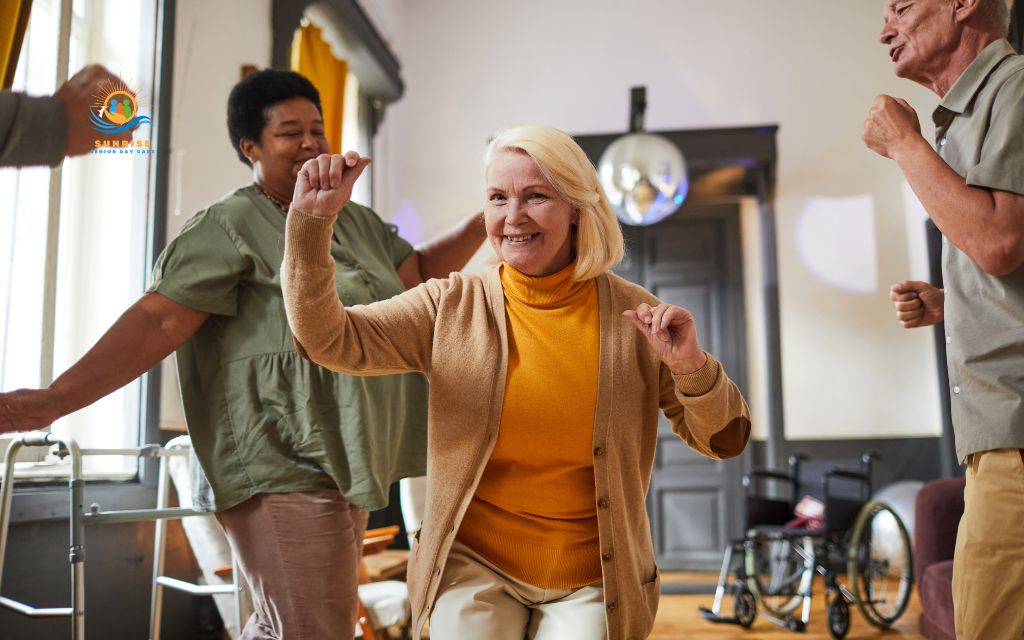What is a retirement community? If you’ve found yourself wondering about this, you’re not alone. The landscape of senior living can feel like alphabet soup and it’s natural to feel confused.
This guide is designed to help Denver seniors and their families understand what retirement communities are, how they work, and how to decide if one is right for you.
We’ll cut through the confusion with straightforward information, real cost ranges for the Denver area, and honest insights into when community living makes sense. Let’s go!

What is a retirement community?
A retirement community is a residential setting designed for older adults who want to live independently while enjoying access to amenities, social activities, and support services that make daily life easier and safer.
A retirement community is not a nursing home, not a hospital, not a place where independence disappears. Instead, think of it as intentional living, where the focus is on living well, not being cared for.
At its core, living in a retirement community means choosing an environment where:
- Maintenance-free housing takes the burden off your shoulders. No more worrying about roof repairs, snow removal, or lawn care. Your time becomes truly your own.
- Social and wellness programs are built into daily life. From fitness classes to book clubs, art workshops, and group outings, there are opportunities to connect with others who share your interests and life experience.
- Safety and on-site assistance provide peace of mind. Emergency response systems, security measures, and staff availability mean help is there if you need it.
Types of retirement communities
One of the most confusing aspects of exploring senior living is understanding the different types available. Each serves a distinct purpose and population, and knowing the differences can help you identify what truly matches your needs.
55+ active adult communities
These age-restricted neighborhoods are designed for healthy, independent retirees who want an active lifestyle without the maintenance responsibilities of traditional homeownership.
- Level of support: None, residents are fully independent
- What to expect: Single-family homes, condos, or apartments in a community setting with amenities like clubhouses, pools, golf courses, and organized social activities. You own or rent your home and are responsible for your own meals and personal care.
- Best for: Independent, healthy retirees who want to be around peers and enjoy resort-style amenities without the burden of yard work.
Independent living communities
These communities offer apartment-style living with services that eliminate daily chores while maximizing time for what you enjoy.
- Level of support: Light support with daily conveniences
- What to expect: Private apartments with communal dining rooms, housekeeping services, transportation, maintenance, and a full calendar of activities. Meals are included, and staff are available for assistance, though residents handle their own personal care.
- Best for: Retirees seeking convenience and social life who are largely independent but ready to shed the responsibilities of home maintenance
Assisted living communities
As needs increase, assisted living communities provide the next level of support. Here, staff assist with daily activities while respecting each resident’s dignity and remaining abilities.
- Level of support: Moderate assistance with activities of daily living
- What to expect: Private or semi-private apartments with 24-hour staff available to help with bathing, dressing, medication management, and mobility. All meals, housekeeping, and social programming are included. Medical care is coordinated but typically provided by outside physicians.
- Best for: Seniors needing regular help with daily tasks but want to maintain as much control over their lives as possible
Continuing care retirement communities (life plan communities)
These communities represent the most comprehensive approach to retirement living, offering a full continuum of care on one campus.
- Level of support: Varies from independent to skilled nursing, all in one location
- What to expect: Residents start in independent living and can transition to higher levels of care as needed without leaving the community. This requires a significant entrance fee plus monthly charges, but provides long-term security and eliminates future moving stress.
- Best for: Long-term planners seeking stability and the assurance that they can age in place regardless of future health changes

Memory care communities
Specialized communities designed specifically for individuals with Alzheimer’s disease, dementia, or other cognitive impairments.
- Level of support: High, with trained staff and secure environments
- What to expect: Secure units designed to prevent wandering, staff trained in dementia care, specialized programming that supports cognitive function, and higher staff-to-resident ratios.
- Best for: Individuals with cognitive conditions who need a safe, structured environment with specialized support
Benefits of moving to a retirement community
The decision to explore retirement community living often stems from recognizing that something needs to change. But beyond addressing challenges, these communities offer genuine benefits that can transform daily life:
Social connection
Loneliness is one of the most significant health risks facing older adults – comparable to smoking 15 cigarettes a day, according to research. In a retirement community, you have to work hard to create social connection; it’s woven into the environment.
There are neighbors in the hallway, companions at mealtimes, and always someone interested in joining you for an activity. You can be as social as you want, when you want, without the isolation that can creep into living alone in a traditional home.
Friendships form naturally around shared interests – whether that’s a walking group exploring parks or a weekly poker game.
Safety and security
Emergency call systems in every apartment mean help is available 24/7. Staff members conduct regular wellness checks.
Buildings are designed with accessibility in mind, grab bars where you need them, and well-lit pathways. Many communities have security personnel and controlled access, providing both practical safety and psychological comfort.
For families, this aspect alone often brings tremendous relief. Instead of worrying about a parent living alone, they know someone is always nearby if needed.
Convenience
Imagine never shoveling snow again. Never scheduling a plumber or waiting for the lawn service. Never plan meals or grocery shopping unless you want to. In a retirement community, these time-consuming tasks are handled for you. The time and energy you once spent on these necessities is now available for what you actually enjoy.
Wellness and healthcare
Most retirement communities offer fitness centers with classes designed for older adults. Many have partnerships with healthcare providers, making it easy to access physical therapy, health screenings, and wellness programs on-site.
Living in a retirement community means living in an environment where healthy aging is the norm, where staying active is encouraged and supported, and where you’re surrounded by peers who motivate each other to keep moving.
Peace of mind
Perhaps the most profound benefit is intangible: the peace of mind that comes from knowing you’re in a secure environment, surrounded by community, and freed from the worries of home maintenance.
For adult children, knowing a parent is safe, engaged, and cared for allows them to return to simply being a son or daughter – enjoying visits without the stress of being the primary caregiver, maintenance person, and social coordinator all at once.

Cost of retirement communities in denver
Let’s address one of the most pressing concerns head-on: affordability. The cost of retirement communities can feel overwhelming at first glance, but understanding what you’re actually paying for often reveals a different picture.
Understanding the investment
Retirement community costs vary significantly based on three factors: the level of service provided, the location within the Denver metro area, and the amenities offered. More support and services naturally mean higher monthly fees, while premium locations and luxury amenities command premium prices.
Average monthly cost ranges
Based on current Denver-area market rates:
- 55+ / Independent Living: $2,500 – $4,000 per month. This includes your apartment, utilities, some meals, housekeeping, maintenance, activities programming, and often transportation services.
- Assisted Living: $4,500 – $6,000 per month. This includes everything from independent living plus personal care assistance with activities like bathing, dressing, medication management, and frequent wellness monitoring.
- Continuing Care / Life Plan Communities: Entrance fee (typically $100,000 – $500,000+) plus $4,000 – $6,500 per month. The entrance fee model provides access to the full continuum of care. Monthly fees cover housing, meals, services, and guaranteed access to higher levels of care without additional entrance fees if your needs change.
What’s actually included
Most retirement communities include:
- Rent or housing costs
- Multiple daily meals prepared by professional chefs
- Weekly housekeeping and linen service
- All maintenance and repairs
- Utilities (often including cable/internet)
- Activities, events, and educational programming
- Transportation to appointments and shopping
- Access to fitness facilities and wellness programs
- Emergency response systems
- Common area amenities (libraries, theaters, salons)
When you itemize what these services would cost separately, the math often looks different than expected.
The value proposition
Yes, retirement communities represent a significant monthly expense. But for many seniors, the value isn’t just financial – it’s about quality of life. The question isn’t just “Can I afford this?” but also “Can I afford not to do this?”
When home maintenance feels overwhelming, isolation is affecting your mood, or you’re spending money on services that could be bundled more efficiently, a retirement community often represents both practical and emotional value.
When to consider moving to a retirement community
Here are common signs that it might be time to explore your options:
Home upkeep feels overwhelming
If you find yourself dreading the next repair project, if yard work exhausts you, or if you’re avoiding necessary home maintenance because it’s simply too much, your home may have become a burden rather than a sanctuary. This is often the first sign that a maintenance-free lifestyle would improve quality of life.
Increased isolation or loneliness
- Have friends moved away or passed away?
- Are you driving less and therefore getting out less?
- Do days pass without meaningful conversation?
Social isolation impacts mental and physical health. If loneliness has become a frequent companion, a retirement community’s built-in social structure can be life-changing.

Concerns about falls or safety
- Have you experienced a fall, or do you worry about falling when you’re alone?
- Are stairs becoming difficult?
- Do you feel anxious about being by yourself, especially at night?
These safety concerns are valid and important and they’re exactly what retirement communities are designed to address.
Medication management challenges
If keeping track of multiple medications is becoming confusing, if you’ve missed doses or taken incorrect amounts, assisted living can provide the structure and oversight needed to manage complex medication regimens safely.
Desire for more structure or social life
Perhaps you’re newly retired and want to be around active peers. Maybe you’re tired of planning every meal and every outing yourself. A retirement community offers structure, variety, and spontaneous opportunities that can reinvigorate daily life.
Family members are expressing concern
When adult children start calling more frequently to check on you, when they express worry about your living situation, or when you notice them trying to manage your life from a distance, these are signals worth taking seriously. Their concern comes from love and might reflect realities you’re not fully seeing.
How to choose the right retirement community in Denver
Once you’ve decided to explore retirement communities, the selection process can feel daunting. Denver’s senior living landscape offers many options, which is wonderful – but also requires careful evaluation.
Here’s a step-by-step guide to finding the right fit:
Step 1: Identify your priorities
Before touring communities, clarify what matters most to you. Consider:
- Location: Do you want to stay in your current neighborhood near familiar places and people? Or are you open to exploring other areas of the metro?
- Budget: What can you afford monthly? Factor in potential rent increases over time.
- Social atmosphere: Do you want a bustling, activity-packed environment or a quieter, more relaxed setting?
- Healthcare access: How important is proximity to your current doctors or hospitals like UCHealth or Denver Health?
- Amenities: What features are essential versus nice-to-have? Fitness center, library, outdoor spaces, cultural programming?
- Spiritual life: If faith is important, does the community accommodate or facilitate religious practice?
Write down your top five priorities. This list will guide every tour and conversation.
Step 2: Schedule community tours
Research communities that align with your priorities and budget, then schedule tours. Visit at least 3 to 5 communities to get a real sense of your options.
Don’t settle for virtual tours alone, you need to experience the atmosphere in person.
What to observe during tours:
- Staff-resident interactions: Do staff members greet residents by name? Do interactions feel genuine and respectful? Is there laughter and warmth, or does it feel institutional?
- Resident engagement: Do residents seem active and happy? Are common areas being used, or are they empty? Talk to residents if possible because they’ll give you honest insights.
- Cleanliness and maintenance: Are common areas and visible apartments well-maintained? Does the community smell fresh? Are safety features apparent?
- Atmosphere: Can you imagine yourself living here? Does it feel like a home or an institution?
Step 3: Review dining options and activity calendars
Request a sample menu and eat a meal at the community if possible. Food quality varies, and since meals are a central part of community life, you want to ensure the cuisine meets your standards and dietary needs.
Ask to see the monthly activity calendar. Does it offer variety? Are there activities that genuinely interest you? Is there flexibility, or does the schedule feel rigid? The calendar reveals whether the community understands and serves its residents’ interests.
Step 4: Ask about emergency systems and medical partnerships
Understand the safety infrastructure:
- What emergency response systems are in place?
- How quickly can staff respond to calls?
- What partnerships exist with hospitals and healthcare providers?
- Is there on-site nursing or health oversight?
- How are medical emergencies handled?
- What happens if your health needs change?
For continuing care communities, understand what the contract promises regarding future care access and costs.
Step 5: Compare costs, contracts, and amenities
Request detailed pricing information and contract terms from each community. Specifically ask about:
- What’s included in the base monthly fee?
- What services cost extra?
- How often do fees increase, and by how much historically?
- What’s the policy if you need to leave?
- Are entrance fees refundable?
- What happens to your fees if you transition to a higher level of care?
Consider having an elder law attorney review contracts before signing, especially for continuing care communities with significant entrance fees.
Step 6: Trust your instincts
After gathering all the data, pay attention to how each community makes you feel. Which one could you most easily imagine as home? Where did you feel most comfortable? Sometimes the intangible “fit” matters as much as the practical details.
Taking time to choose carefully means you’re much more likely to find a community where you’ll genuinely thrive.

Conclusion
Exploring retirement community options is about prioritizing safety, connection, and freedom from daily burdens that may be affecting your quality of life. Denver offers diverse retirement communities that match different needs and budgets. Whether you’re seeking independent living or assisted living, options exist designed for your specific situation.
The advantage of exploring now is that you remain in control. You choose the timing, the community, and how you want to live. You’re planning proactively, not reacting to an emergency.
Sunrise Senior Daycare – Denver Adult Day Programs
If you’re not ready for a retirement community but want daytime support, Sunrise Senior Daycare offers engaging adult day programs in the Denver area. We provide a safe environment with fitness activities, social connection, nutritious meals, and cognitive enrichment helping seniors stay active.
While we specialize in daytime care, we understand families exploring senior living options. We’re happy to answer questions about adult day services and share information about care options in Denver.
For more information: (303) 226-6882
Frequently asked questions (FAQs)
What is a retirement community and how does it work?
A retirement community is residential housing designed for older adults, offering private apartments or homes with services like meals, housekeeping, maintenance, and social activities. Residents live independently while accessing support that makes daily life easier and safer.
How much does it cost to live in a retirement community in Denver?
Independent living runs $2,500 – $4,000 monthly; assisted living costs $4,500 – $6,000 monthly. Continuing care communities require entrance fees ($100,000+) plus monthly fees. Costs typically include housing, meals, housekeeping, maintenance, and activities. Exact pricing depends on location, services, and amenities.
What are the different types of retirement communities?
5 main types exist: 55+ Active Adult Communities, Independent Living, Assisted Living , Continuing Care Communities, and Memory Care. Each serves different independence levels and care needs.
How is a retirement community different from assisted living?
“Retirement community” describes various senior housing options. Assisted living is one specific type that provides personal care help – bathing, dressing, medication management – while maintaining resident independence. Other retirement communities, like 55+ neighborhoods or independent living, offer no personal care assistance.
When is the right time to move to a retirement community?
Consider moving when: home maintenance becomes overwhelming, you feel isolated, you’re concerned about safety or falls, medication management is challenging, or you want more social structure. The best time is often before it becomes urgent – while you can choose and adjust comfortably. Trust your instincts and listen to family concerns.




